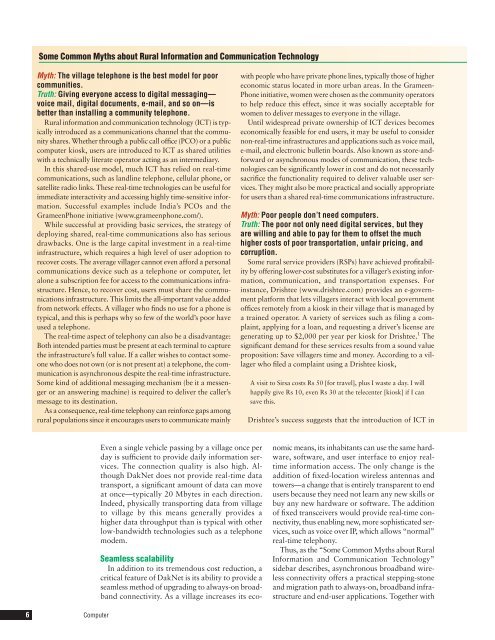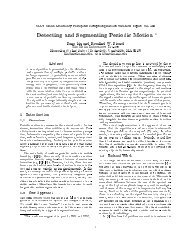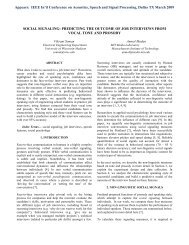DakNet: Rethinking Connectivity in Developing Nations - First Mile ...
DakNet: Rethinking Connectivity in Developing Nations - First Mile ...
DakNet: Rethinking Connectivity in Developing Nations - First Mile ...
You also want an ePaper? Increase the reach of your titles
YUMPU automatically turns print PDFs into web optimized ePapers that Google loves.
Some Common Myths about Rural Information and Communication Technology<br />
Myth: The village telephone is the best model for poor<br />
communities.<br />
Truth: Giv<strong>in</strong>g everyone access to digital messag<strong>in</strong>g—<br />
voice mail, digital documents, e-mail, and so on—is<br />
better than <strong>in</strong>stall<strong>in</strong>g a community telephone.<br />
Rural <strong>in</strong>formation and communication technology (ICT) is typically<br />
<strong>in</strong>troduced as a communications channel that the community<br />
shares. Whether through a public call office (PCO) or a public<br />
computer kiosk, users are <strong>in</strong>troduced to ICT as shared utilities<br />
with a technically literate operator act<strong>in</strong>g as an <strong>in</strong>termediary.<br />
In this shared-use model, much ICT has relied on real-time<br />
communications, such as landl<strong>in</strong>e telephone, cellular phone, or<br />
satellite radio l<strong>in</strong>ks. These real-time technologies can be useful for<br />
immediate <strong>in</strong>teractivity and access<strong>in</strong>g highly time-sensitive <strong>in</strong>formation.<br />
Successful examples <strong>in</strong>clude India’s PCOs and the<br />
GrameenPhone <strong>in</strong>itiative (www.grameenphone.com/).<br />
While successful at provid<strong>in</strong>g basic services, the strategy of<br />
deploy<strong>in</strong>g shared, real-time communications also has serious<br />
drawbacks. One is the large capital <strong>in</strong>vestment <strong>in</strong> a real-time<br />
<strong>in</strong>frastructure, which requires a high level of user adoption to<br />
recover costs. The average villager cannot even afford a personal<br />
communications device such as a telephone or computer, let<br />
alone a subscription fee for access to the communications <strong>in</strong>frastructure.<br />
Hence, to recover cost, users must share the communications<br />
<strong>in</strong>frastructure. This limits the all-important value added<br />
from network effects. A villager who f<strong>in</strong>ds no use for a phone is<br />
typical, and this is perhaps why so few of the world’s poor have<br />
used a telephone.<br />
The real-time aspect of telephony can also be a disadvantage:<br />
Both <strong>in</strong>tended parties must be present at each term<strong>in</strong>al to capture<br />
the <strong>in</strong>frastructure’s full value. If a caller wishes to contact someone<br />
who does not own (or is not present at) a telephone, the communication<br />
is asynchronous despite the real-time <strong>in</strong>frastructure.<br />
Some k<strong>in</strong>d of additional messag<strong>in</strong>g mechanism (be it a messenger<br />
or an answer<strong>in</strong>g mach<strong>in</strong>e) is required to deliver the caller’s<br />
message to its dest<strong>in</strong>ation.<br />
As a consequence, real-time telephony can re<strong>in</strong>force gaps among<br />
rural populations s<strong>in</strong>ce it encourages users to communicate ma<strong>in</strong>ly<br />
with people who have private phone l<strong>in</strong>es, typically those of higher<br />
economic status located <strong>in</strong> more urban areas. In the Grameen-<br />
Phone <strong>in</strong>itiative, women were chosen as the community operators<br />
to help reduce this effect, s<strong>in</strong>ce it was socially acceptable for<br />
women to deliver messages to everyone <strong>in</strong> the village.<br />
Until widespread private ownership of ICT devices becomes<br />
economically feasible for end users, it may be useful to consider<br />
non-real-time <strong>in</strong>frastructures and applications such as voice mail,<br />
e-mail, and electronic bullet<strong>in</strong> boards. Also known as store-andforward<br />
or asynchronous modes of communication, these technologies<br />
can be significantly lower <strong>in</strong> cost and do not necessarily<br />
sacrifice the functionality required to deliver valuable user services.<br />
They might also be more practical and socially appropriate<br />
for users than a shared real-time communications <strong>in</strong>frastructure.<br />
Myth: Poor people don’t need computers.<br />
Truth: The poor not only need digital services, but they<br />
are will<strong>in</strong>g and able to pay for them to offset the much<br />
higher costs of poor transportation, unfair pric<strong>in</strong>g, and<br />
corruption.<br />
Some rural service providers (RSPs) have achieved profitability<br />
by offer<strong>in</strong>g lower-cost substitutes for a villager’s exist<strong>in</strong>g <strong>in</strong>formation,<br />
communication, and transportation expenses. For<br />
<strong>in</strong>stance, Drishtee (www.drishtee.com) provides an e-government<br />
platform that lets villagers <strong>in</strong>teract with local government<br />
offices remotely from a kiosk <strong>in</strong> their village that is managed by<br />
a tra<strong>in</strong>ed operator. A variety of services such as fil<strong>in</strong>g a compla<strong>in</strong>t,<br />
apply<strong>in</strong>g for a loan, and request<strong>in</strong>g a driver’s license are<br />
generat<strong>in</strong>g up to $2,000 per year per kiosk for Drishtee. 1 The<br />
significant demand for these services results from a sound value<br />
proposition: Save villagers time and money. Accord<strong>in</strong>g to a villager<br />
who filed a compla<strong>in</strong>t us<strong>in</strong>g a Drishtee kiosk,<br />
A visit to Sirsa costs Rs 50 [for travel], plus I waste a day. I will<br />
happily give Rs 10, even Rs 30 at the telecenter [kiosk] if I can<br />
save this.<br />
Drishtee’s success suggests that the <strong>in</strong>troduction of ICT <strong>in</strong><br />
Even a s<strong>in</strong>gle vehicle pass<strong>in</strong>g by a village once per<br />
day is sufficient to provide daily <strong>in</strong>formation services.<br />
The connection quality is also high. Although<br />
<strong>DakNet</strong> does not provide real-time data<br />
transport, a significant amount of data can move<br />
at once—typically 20 Mbytes <strong>in</strong> each direction.<br />
Indeed, physically transport<strong>in</strong>g data from village<br />
to village by this means generally provides a<br />
higher data throughput than is typical with other<br />
low-bandwidth technologies such as a telephone<br />
modem.<br />
Seamless scalability<br />
In addition to its tremendous cost reduction, a<br />
critical feature of <strong>DakNet</strong> is its ability to provide a<br />
seamless method of upgrad<strong>in</strong>g to always-on broadband<br />
connectivity. As a village <strong>in</strong>creases its economic<br />
means, its <strong>in</strong>habitants can use the same hardware,<br />
software, and user <strong>in</strong>terface to enjoy realtime<br />
<strong>in</strong>formation access. The only change is the<br />
addition of fixed-location wireless antennas and<br />
towers—a change that is entirely transparent to end<br />
users because they need not learn any new skills or<br />
buy any new hardware or software. The addition<br />
of fixed transceivers would provide real-time connectivity,<br />
thus enabl<strong>in</strong>g new, more sophisticated services,<br />
such as voice over IP, which allows “normal”<br />
real-time telephony.<br />
Thus, as the “Some Common Myths about Rural<br />
Information and Communication Technology”<br />
sidebar describes, asynchronous broadband wireless<br />
connectivity offers a practical stepp<strong>in</strong>g-stone<br />
and migration path to always-on, broadband <strong>in</strong>frastructure<br />
and end-user applications. Together with<br />
6 Computer






